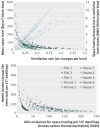Home energy efficiency and radon related risk of lung cancer: modelling study
- PMID: 24415631
- PMCID: PMC3898159
- DOI: 10.1136/bmj.f7493
Home energy efficiency and radon related risk of lung cancer: modelling study
Abstract
Objective: To investigate the effect of reducing home ventilation as part of household energy efficiency measures on deaths from radon related lung cancer.
Design: Modelling study.
Setting: England.
Intervention: Home energy efficiency interventions, motivated in part by targets for reducing greenhouse gases, which entail reduction in uncontrolled ventilation in keeping with good practice guidance.
Main outcome measures: Modelled current and future distributions of indoor radon levels for the English housing stock and associated changes in life years due to lung cancer mortality, estimated using life tables.
Results: Increasing the air tightness of dwellings (without compensatory purpose-provided ventilation) increased mean indoor radon concentrations by an estimated 56.6%, from 21.2 becquerels per cubic metre (Bq/m(3)) to 33.2 Bq/m(3). After the lag in lung cancer onset, this would result in an additional annual burden of 4700 life years lost and (at peak) 278 deaths. The increases in radon levels for the millions of homes that would contribute most of the additional burden are below the threshold at which radon remediation measures are cost effective. Fitting extraction fans and trickle ventilators to restore ventilation will help offset the additional burden but only if the ventilation related energy efficiency gains are lost. Mechanical ventilation systems with heat recovery may lower radon levels and the risk of cancer while maintaining the advantage of energy efficiency for the most airtight dwellings but there is potential for a major adverse impact on health if such systems fail.
Conclusion: Unless specific remediation is used, reducing the ventilation of dwellings will improve energy efficiency only at the expense of population wide adverse impact on indoor exposure to radon and risk of lung cancer. The implications of this and other consequences of changes to ventilation need to be carefully evaluated to ensure that the desirable health and environmental benefits of home energy efficiency are not compromised by avoidable negative impacts on indoor air quality.
Conflict of interest statement
Competing interests: All authors have completed the ICMJE uniform disclosure form at
Figures





Comment in
-
Cutting household ventilation to improve energy efficiency.BMJ. 2014 Jan 10;348:f7713. doi: 10.1136/bmj.f7713. BMJ. 2014. PMID: 24415632 No abstract available.
References
-
- HM Government. Climate change act. Stationery Office, 2008.
-
- Committee on Climate Change. Building a low-carbon economy—the UK’s contribution to tackling climate change. First report. Committee on Climate Change, 2008.
-
- Department of Energy and Climate Change. The energy efficiency strategy: the energy efficiency opportunity in the UK. Stationery Office, 2012.
-
- Oreszczyn T, Hong S, Ridley I, Wilkinson P. Determinants of winter indoor temperatures in low income households in England. Energy Build 2006;38:245-52.
-
- Hänninen O, Palonen J, Tuomisto J, Yli-Tuomi T, Seppänen O, Jantunen M. Reduction potential of urban PM2.5 mortality risk using modern ventilation systems in buildings. Indoor Air 2005;15:246-56. - PubMed
Publication types
MeSH terms
Substances
LinkOut - more resources
Full Text Sources
Other Literature Sources
Medical
